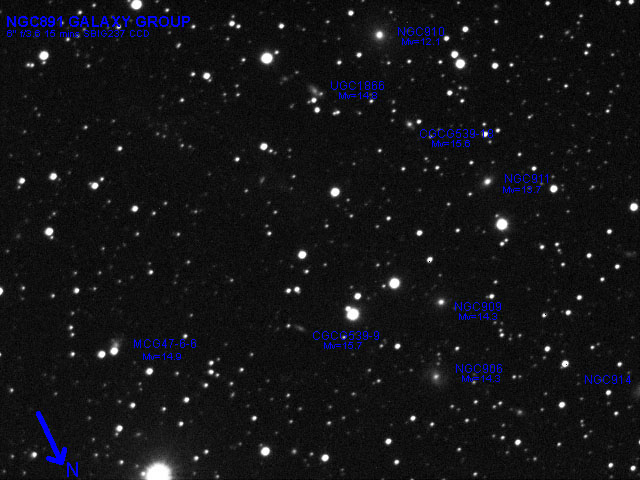Previous Uploads: Three faces of Comet Linear Comet Linear A2 6-27-01 Van Cittert Deconvolution of the Lunar Highlands More Northern Lights and the ISS over Payson The NGC891 Galaxy Group Notes CCD Shots during Full Moon Comet Linear July 19 & 25th, 2000 Latest image of Comet Linear S4 Spectacular Red Aurora over Payson Arizona Fuji's New Formulation of it new Super HQ100 FIRST TESTS OF HYPERED FUJI HQ100 First Schmidt shots with PJ400 First Tricolor shots with 2415 Test Images with Fuji NPH400 First Two Comets with the new CCD Camera
Last month, during the Cherry Road star party, myself and Bernie Sanden decided to go look for the main galaxy cluster about half a degree southeast of the well-known edge on spiral galaxy NGC 891 in the constellation of Andromeda. This very faint cluster of galaxies, is composed of over 1 dozen members, ranging in brightness from about 12.5 magnitude, too much fainter. Visually, in my 20 in. telescope at moderate magnifications, we were able to spot at least seven extremely faint galaxies spread out in an approximately north-south line, most of which were at the extreme limit of detectability.
The next evening, the CCD image illustrated below was taken from my backyard and Payson, with a short focus six inch Schmidt Newtonian for a duration of 15 minutes exposure. I could just barely see the bright NGC891 Galaxy, and using a map generated in Megastar, star hopped faint star by faint star to the target destination. Absolutely no Galaxies or any nebulous objects at all were spotted visually even at high-power with the six inch. When the first five-minute exposure scrolled upon the screen in the series, I was totally amazed to see at least a dozen galaxies! The three images were later combined using Maxim DL software to provide the final image. In addition to labeling the identification of the galaxies, I also put the magnitude of the Galaxy with it as well. Many of the small unlabeled galaxies, go well beyond 16th magnitude, with the stellar images in the shot approximately 19 magnitude. Of special notice, is NGC906. Look closely at this 14.3 magnitude object, you'll see very clear spiral structure. All of this in 15 minutes, with the six inch RFT. The field is exactly half a degree wide.
